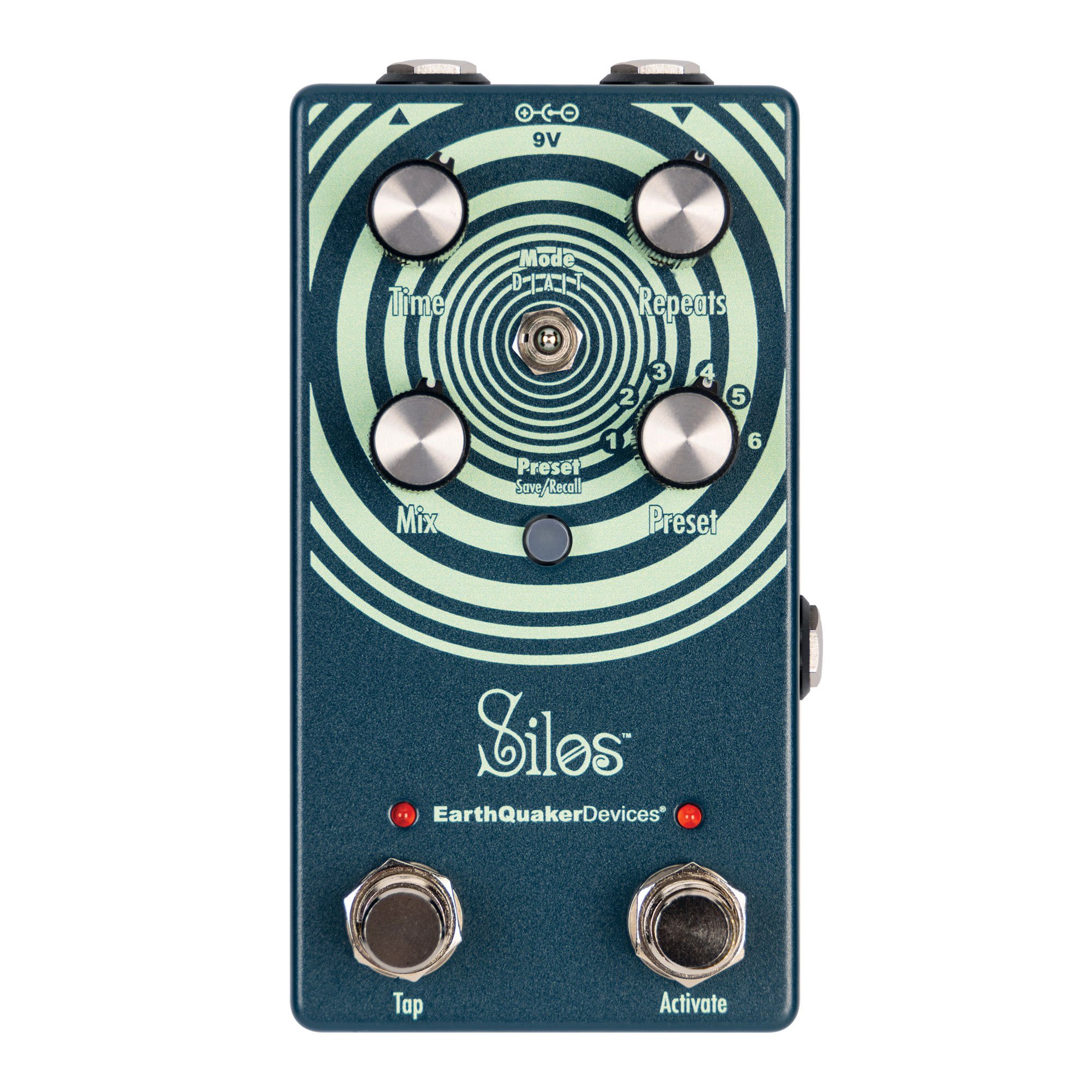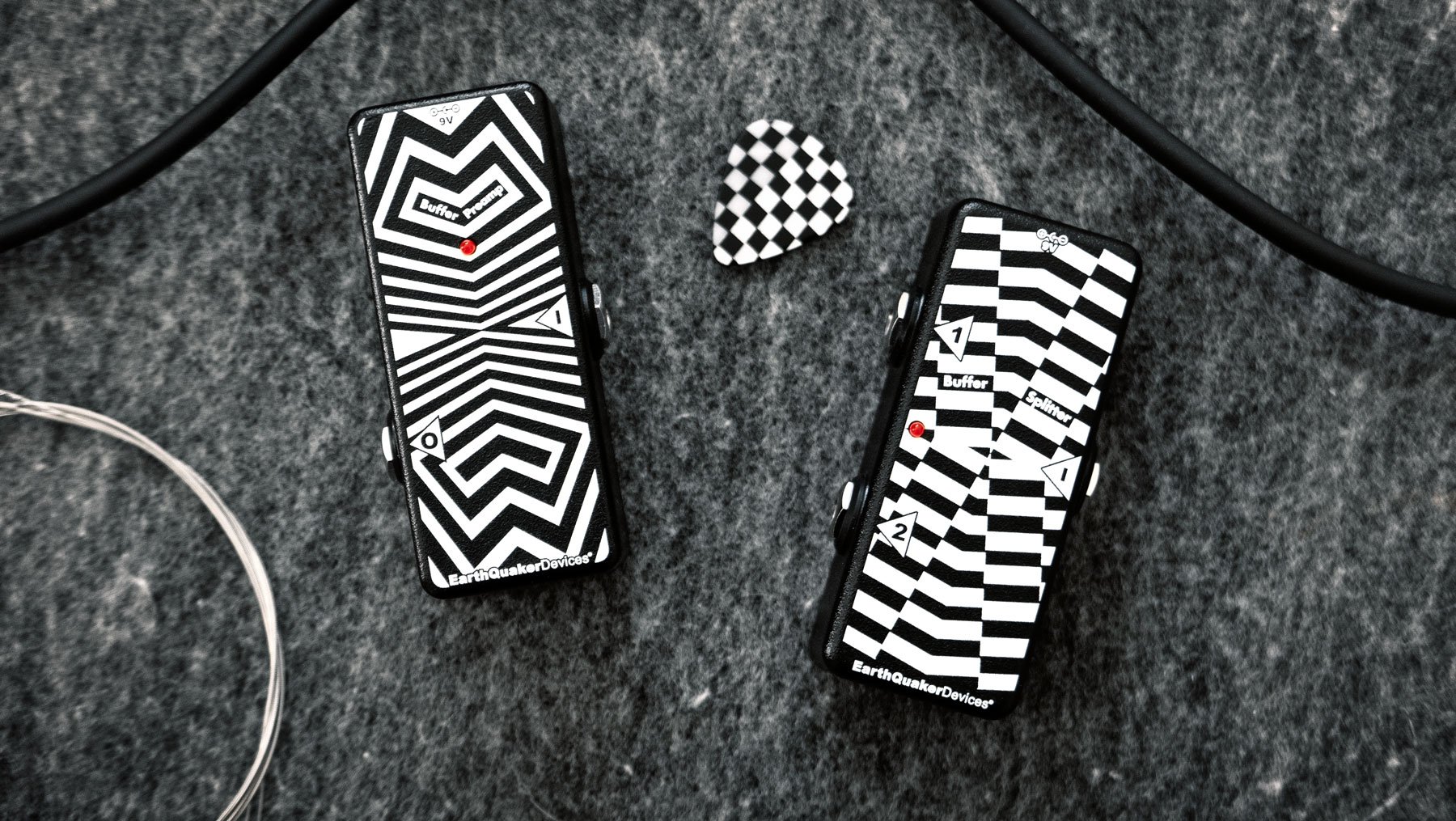Time Traveling with Silos
Dan Epstein
At some point in our lives, all of us have wished we could have access to a time machine. Whether you’re looking to right old wrongs, dreaming of being a fly on the wall at some significant historical event, or wishing to hop a few decades forward just to see how out current messes are gonna pan out, it would be pretty sweet indeed to just jump into a flux capacitor-equipped DeLorean (or something similar) and set the controls for the date of your choice.
Alas, even though scientists say time travel is theoretically possible, such options don’t yet appear to be available to us, at least not corporeally. But if you’d like to try time traveling from a sonic perspective, hitch a ride on Silos, EarthQuaker’s new tri-mode delay pedal — or, rather, Multi-Generational Time Reflection Device.
Yes, that’s “multi-generational” in the sense that this ingenious little stompbox contains three separate operational modes (Digital, Analog and Tape) that can generate a wide array of delicious delay tones — as well as delay times ranging from zero milliseconds to a whole second — with just a tweak of its Mix, Time and Repeats controls. Which is pretty damn cool in and of itself, as are additional features like the Save/Recall button that allows you to save up to six presets, a Preset knob that accesses them, a user-assignable expression control jack, a dedicated Tap Tempo footswitch, and a buffered bypass Activate footswitch which lets the delay trails naturally decay even when you abruptly kick it off.
But Silos is also multi-generational in the sense that it can transport you to any number of sounds and textures from the past sixty-plus years, while also giving you the tools to create the music of the future. Whether you’re seeking the pristine repeats of a digital delay, the quirky character of an analog “bucket brigade” delay, or the atmospheric colors of an old-school tape delay, Silos will take you there. Climb aboard, plug in your guitar, and let us show you what we mean!
304 HOLLOWAY ROAD
Our first stop on this Silos tour is 1962, where maverick producer Joe Meek has built a home studio in a third-floor flat above a leather goods shop on North London’s Holloway Road. One of the first people to grasp the notion of using a recording studio as an instrument unto itself, Meek gleefully experiments with massive amounts of compression, distortion, reverb and tape delay to create the otherworldly sounds heard on his hit productions like “Telstar” by The Tornados. (It is rumored that the “rocket launch” effect at the beginning of that record is actually a tape of a flushing toilet slowed down and replayed backwards.)
To create a delay sound that fits right in with the new, futuristic world that Meek hears in his head, switch the Silos mode to T (Tape Delay), set the Mix control to 2 o’clock for a strong delay signal, set the Time control to 9 o’clock for a fast delay time in the 200-300 millisecond range, and set the Repeats control at just a hair before 3 o’clock to keep the delay right on the edge of self-oscillation. The freaky, pingy effect this setting produces — especially on high-pitched single-note melodies — sounds even cooler when you throw some compression and reverb into your signal chain (may we suggest an EQD Warden Optical Compressor and a Ledges Reverb?). But even on its own, this setting will supercharge your guitar with the sound of the future, 1960s-style.
MAGGOT BRAINED
Our next stop on this sonic time-travel tour finds us landing in early 1971 at Detroit’s United Sound Systems recording studio, where George Clinton is leading the original Funkadelic lineup through the recording of what will turn out to be their final album together. “Maggot Brain,” the album’s title track, is a slow-building ten-minute instrumental dominated by wailing guitar of Eddie Hazel; before rolling tape, Clinton has instructed Hazel to play it like he’s just gotten the news that his mother is dead. It’s a searing and understandably emotional performance, one made even more haunting by Clinton’s LSD-influenced decision to run the tape through an Echoplex multiple times.
To get that dark and moody “Maggot Brain” sound, keep Silos in Mode T, dial the Mix control down to 9 o’clock, set the delay Time to 11 o’clock (or roughly 450 milliseconds), and set the Repeats at around 10 o’clock to get a similar four-repeat delay. A little gain on your guitar (provided by, say, EarthQuaker’s Plumes overdrive) will add nicely to the murk of the degrading signal; and while it’s not quite the same as having an acid-crazed Dr. Funkenstein twiddling the knobs, you can achieve a similarly disorienting effect by assigning the Mix control to your expression pedal, and bringing the delay signal up or down with your foot as you play.
RUNNING LIKE HELL
On our next Silos stop, we’ll touch down briefly in 1979 at one of the several studios where Pink Floyd are fractiously building their forthcoming opus The Wall. Guitarist David Gilmour’s affinity for the Binson Echorec is well known, but in the last few years he’s been experimenting with digital delays to get longer and more precise delay effects. “Run Like Hell,” a new track he’s been working on for the album, features a funky, palm-muted riff and a ringing refrain, both of which are notably enhanced by a digital delay.
While it’s difficult to fully replicate Gilmour’s double-tracked “Run Like Hell” parts without running your guitar in stereo between two different amps and delays, this Silos setting will put you solidly in the, er, Wallpark: With Mode D (Digital) selected, turn the Time knob to around 10 o’clock for a delay time in the 350-400 millisecond range; then set the Mix at around 10:30 and the Repeats at about 1 o’clock to get about seven or eight repeats that are audible without being overbearing. Throw a little gain and reverb into the signal chain to really make it sing… but then you’d better run like hell before Roger Waters comes in and angrily wonders what the hell you’re doing here!
LIVING ON THE EDGE
Of course, we can’t talk about classic delay effects without bringing The Edge into the discussion, since his delay-drenched guitar sound not only defined U2’s music but also influenced countless guitarists in the 1980s and beyond. So this next stop on the Silos time travel tour finds us alighting at Ireland’s Slane Castle in the summer of 1984 to check him out as he works on The Unforgettable Fire.
Sure, The Edge achieves his patented “guitar wash” by running his axe through a variety of delays (some analog, some digital) and multiple amplifiers. But if you’re looking for a more cost-efficient route to a similarly Edge-y attack, just keep Silos at Mode D, turn the Time to around 11 o’clock, the Repeats knobs to noon, and the Mix control to two o’clock for a sturdy delay sound. Boost your signal with a bit of gain, then strike a chord; once you get the feel of the 450 millisecond repeats, start playing in between or against them to get that “In the Name of Love” sound. If the song you’re playing requires a faster or slower tempo, just adjust the Time knob manually (or with an expression pedal) or tap the Tap Tempo switch accordingly, and “U2” can impress your bandmates with your intrinsic Edge-iness.
COPPING THE KARMA
Our next stop on this sonic time-travel tour is St. Catherine’s Court in Bath, England, in late 1996, where Radiohead are presently constructing their era-defining OK Computer. “Karma Police,” one of the album’s key tracks, goes wonderfully wonky during its last minute, thanks to Ed O’Brien’s use of an Electro-Harmonix Deluxe Memory Man to wheel his distorted guitar tone in and out of self-oscillation.
If you have an expression pedal, you can achieve a similar effect with Silos. After putting Silos in Mode A (Analog), crank the Time to 5 for a full one-second delay, put the Mix at noon, then assign the Repeats mode to the expression pedal. As you play, the delay repeats will degrade and pile up — and when you rock the expression pedal all the way forward, the self-oscillation effect will kick in hard, producing a throbbing, distorted sound that you can then pull back as needed. You can also access a similar sound without an expression pedal, by setting the Repeats to about 3:30, as anything after 3 o’clock in Mode A or T will unleash the self-oscillation beast. But be warned: keep your hand or toe in very close proximity to that Repeats knob, because those oscillations can get crazy loud pretty damn quickly!
NEROTIC
For our last stop on this time-travel tour, let’s land in Port Jefferson, New York, where progressive/indie/math rock trio Covet are finishing up their 2020 album Technicolor. While compression is a major component of guitar phenom Yvette Young’s sonic arsenal, analog delay is the secret sauce to her intricate tapping patterns and fingerstyle runs.
To achieve a similar delay as the one she uses on Covet’s head-spinning track “Nero,” keep Silos in Mode A, dial the Time control to 11 o’clock, the Mix control to 10 o’clock, and the Repeats control down to 8 o’clock. This setting gives you a single repeat of about 450 milliseconds, and the low Mix setting makes it sound and feel almost like a slap-back echo, albeit with slightly more heft. Combined with a nice dose of compression, it’ll bring your tapped and fingerpicked passages to sparkling life — and it’ll sound pretty sweet when applied to wailing leads, as well!
Dan Epstein is an author, editor, journalist and guitarist based in New York's Hudson Valley. He writes about his latest musical obsessions at Jagged Time Lapse, and songs from his latest musical project The Corinthian Columns can be found at corinthiancolumns.bandcamp.com












